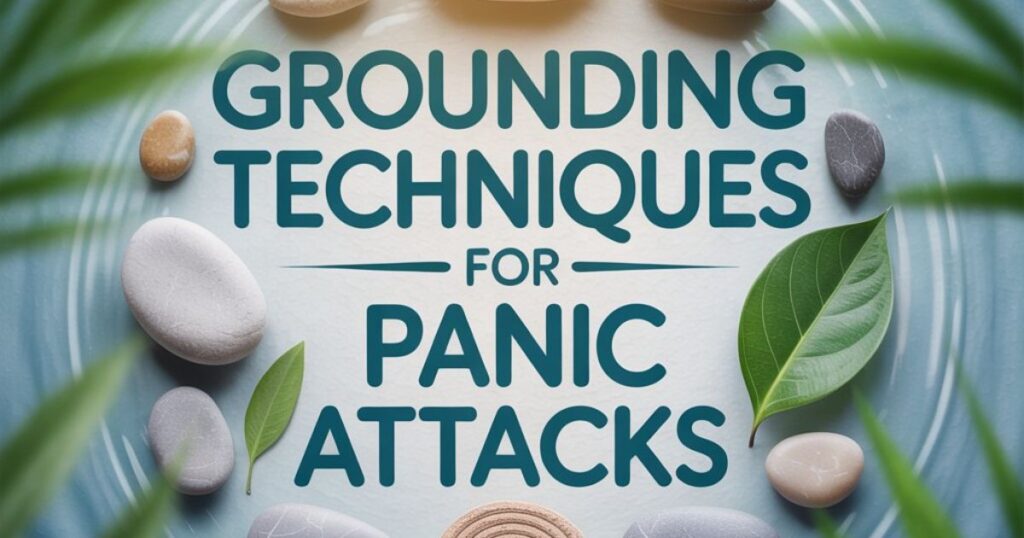Introduction: Grounding Techniques for Panic Attacks
Panic attacks can hit without warning — your heart races, thoughts spin, and it feels like you’re losing control. That’s where grounding techniques for panic attacks come in. These science-backed methods help you refocus on the present moment, offering relief from anxious feelings, challenging emotions, and even flashbacks.
Whether you’re in the middle of an episode or trying to prevent one, grounding helps you feel more in control. It works by connecting your mind back to your body using physical grounding and mental strategies. In this guide, you’ll explore calming techniques that actually work — even a few you’ve probably never tried before. Let’s break free from the fear, one deep breath at a time.
What Are Grounding Techniques for Panic Attacks?
What is grounding? It’s a method used to refocus on the present moment when your mind feels out of control. It involves using your body or mind to get out of your head and into the now. You might use your five senses exercises, deep breathing, or mental focus to calm a storm inside you.
People use grounding to reduce emotional distress, stop anxious feelings, and create space from distress during panic or dissociation. These tools are easy, fast, and can be done anywhere. For someone who struggles with trauma or PTSD coping, they can feel like a lifeline.
Why Do Panic Attacks Happen? (Causes & Triggers)
Panic attacks are caused by a mix of brain chemistry and life stress. Sometimes, your brain misreads a situation as life-threatening, triggering the fight-or-flight system. That rush of adrenaline brings stress reduction to the edge, causing trembling, racing heart, and intense fear.
Common triggers include crowded places, unwanted memories, sudden changes, caffeine, or trauma reminders. For others, it could be no clear cause at all. That’s why coping strategies like grounding are essential for taking back control when your brain sounds the alarm for no reason.
How Grounding Helps Calm the Mind and Body
When panic strikes, your brain disconnects from the now. Grounding restores this connection. It gives your brain a new job: focus on sights, textures, or thoughts. This helps to calm the mind, regulate breathing, and reduce fear signals.
The key is to use psychological grounding tools that activate your body and thoughts in ways that lower tension. It’s not just about calming; it’s about restoring control. That’s why grounding is a powerful way to begin emotional healing and feel safe.
5 Powerful Physical Grounding Techniques
Physical grounding involves using your body to anchor you back to the present. One proven way is the 5-4-3-2-1 technique. It asks you to name 5 things you see, 4 you can touch, 3 you hear, 2 you smell, and 1 you taste.
Other methods include walking barefoot, touch therapy with textured objects, or holding an ice cube. Even hugging yourself or tapping your arms rhythmically can reduce emotional distress. Each activity wakes up your body and pulls you out of your thoughts.
| Technique | Purpose |
| 5-4-3-2-1 method | Shift focus using five senses |
| Ice cube in hand | Shock senses, create instant focus |
| Hugging self | Brings warmth and safety |
| Deep breathing | Regulates panic signals |
| Walking slowly | Connects body with safe surroundings |
5 Effective Mental Grounding Techniques
Your brain can be your best ally. Mental grounding techniques include saying your name, today’s date, or describing your surroundings out loud. This brings back logic and structure when panic clouds your mind.
Another option is visualization exercises. Imagine your favorite safe place in detail. Recall each color, sound, and texture. Or try listing TV shows you love or doing small math problems. These mental distractions shift your focus and lower the fear.
5 Soothing Emotional Grounding Techniques
Feelings can drown you during panic. That’s where soothing grounding helps. It starts with self-soothing: speak kindly to yourself. Try saying, “This feeling is temporary. I’m safe right now.”
Other tools include hugging a soft blanket, listening to calming music, or keeping a favorite scent near you. These tricks boost emotional regulation and comfort your nervous system during emotional distress.
How to Use Grounding During a Panic Attack (Step-by-Step)
If panic hits, you need steps that work fast. Start by breathing in slowly for 4 seconds, hold for 4, then out for 6. Say your name and something around you out loud. Next, use a five senses exercise like the 5-4-3-2-1 method.
Then, hold something cold, hum your favorite tune, or walk slowly. Each step pulls you away from fear and back to safety. These steps teach you how to ground yourself quickly, even when everything feels overwhelming.
Best Time to Practice Grounding Techniques Daily
You don’t need to wait for a panic attack to ground yourself. In fact, the best ways to calm your mind involve practicing daily. Mornings are perfect for daily grounding methods. Start with a deep breath and a simple grounding statement like, “I am here now.”
Before sleep is another key time. It helps you unwind and release anxious feelings. Add grounding into your routine like brushing teeth: same time, same method. Over time, your brain will learn to switch off panic before it starts.
Grounding vs Other Coping Techniques (Like CBT, Meditation)
Grounding for anxiety and depression works differently from other methods. CBT (Cognitive Behavioral Therapy) trains your thoughts over time. Meditation builds awareness and inner stillness. But grounding is quick, physical, and active.
For someone in immediate panic, grounding is more helpful than meditation, which requires calm focus. That’s why many combine grounding with techniques to reduce stress instantly or use it as the first step before diving into deeper therapy like CBT.
When to Seek Professional Help for Panic Attacks
Grounding helps, but if panic attacks often happen or affect daily life, it’s time to seek help. Professionals offer support, therapy, and medical tools that go beyond natural remedies for anxiety.
If you feel out of control, have flashbacks, or struggle to function, talk to a therapist. You deserve peace. Grounding is just one part of the path. Therapy adds strength, insight, and hope.
Conclusion: How Grounding Can Help You Take Control
You are not your panic. You are powerful. These grounding ideas for trauma, panic, and anxiety are small steps that create big change. With consistent use, they teach your brain how to stay present during anxiety and return to safety.
Don’t just read this guide—practice it. Pick one technique today and make it yours. The more you ground, the more you heal.
FAQs:
What is the instant anxiety pill?
An instant anxiety pill often refers to benzodiazepines like Xanax, which act quickly to calm severe anxiety.
How does sour candy help with anxiety?
Sour candy triggers a strong sensory response that can distract your brain and help interrupt anxious thoughts.
How can I get immediate help for anxiety?
You can call a mental health hotline, talk to a therapist, or try deep breathing and grounding techniques.
What candy is best for anxiety?
Sour candy and dark chocolate are popular; sour flavors can shock the senses while dark chocolate may lower cortisol.
What does yogurt do for anxiety?
Yogurt supports gut health, which is linked to mood; its probiotics may help reduce symptoms of stress and anxiety.



